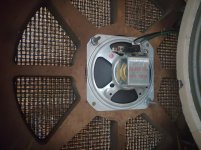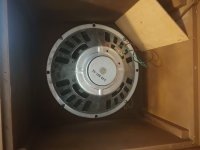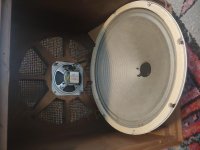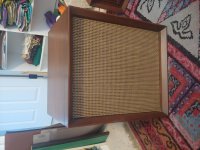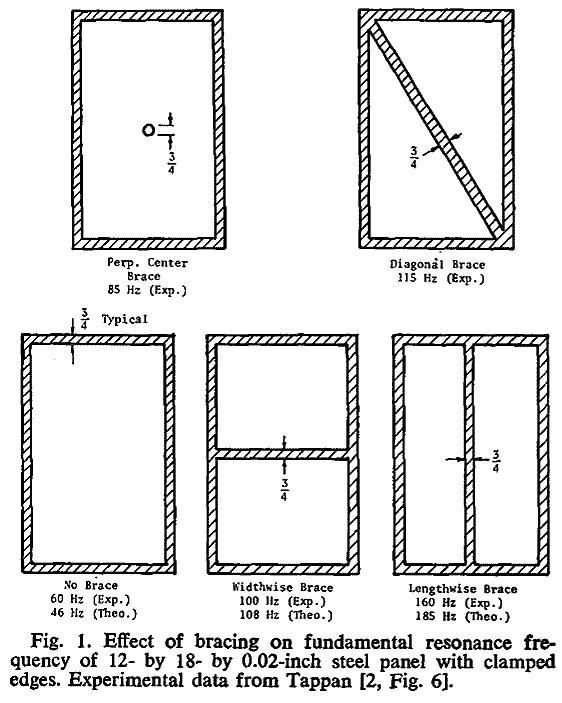I have a pair of 12" Sears Silvertone cabinets that match a 6BQ5 Silvertone stereo receiver. They're nicely made as in they're furniture like and built to last, but they're pretty resonant, especially in the mid-bass. Rap on the cabs and the woofer baskets even give a pretty good ring. I'm planning on replacing the speakers with full range Fanes, but I want to at least get resonance down to kabuki speaker levels.
They're only one cubic foot, so I want very thin and efficient damping. I was thinking Peel and Seal and/or Dynamat stuff. I like the idea of self-adhesive products. And some fiberglass batting on the floor of the cab. Am I barking up the right tree? Are these even tameable? Any way to brace them without woodworking skills?
They're only one cubic foot, so I want very thin and efficient damping. I was thinking Peel and Seal and/or Dynamat stuff. I like the idea of self-adhesive products. And some fiberglass batting on the floor of the cab. Am I barking up the right tree? Are these even tameable? Any way to brace them without woodworking skills?
Attachments
That's an interesting concentric arrangement of woofer and tweeter!
You are thinking along the right lines when it comes to damping the vibration of the enclosure walls.
It wouldn't require advanced woodworking skills to brace the sides of the enclosure with a tight fitting wooden dowel e.g. a broom handle (with glue added for permanency).
You are thinking along the right lines when it comes to damping the vibration of the enclosure walls.
It wouldn't require advanced woodworking skills to brace the sides of the enclosure with a tight fitting wooden dowel e.g. a broom handle (with glue added for permanency).
I agree. You'll likely get best results with some good bracing. If you don't have one, a cheap miter box and saw will be what you want. Easy enough to make square ends. Use dowel or closet pole as Galu suggests. Since there is no lip on the back of the box, they should slip right in.
Be sure you leave room to get the woofer in and out around the braces! 😀
Also see here: Flex Paste for speaker enclosures
Be sure you leave room to get the woofer in and out around the braces! 😀
Also see here: Flex Paste for speaker enclosures
Adding plumber's putty and/or something like adhesive felt to the speaker frame will reduce or eliminate the ringing. Even something as simple as using duct tape on the speaker frame will help.
Mike
Mike
Adding plumber's putty and/or something like adhesive felt to the speaker frame will reduce or eliminate the ringing...
Speaker Tweeks -- Puzzlecoat & Ductseal
(2nd half)
dave
Thank you everyone, you're proving quite useful. I did Google, but these speakers are pretty different in deficiencies from more modern loudspeakers, which would be made of a different wood product and at least bear some hint of acoustic engineering or consideration of resonance -- actually, the resonance works as a boxy acoustic bass boost -- intentionally, probably.
I'm going to consider my options for damping and will add a brace. I haven't been able to find much on the net about people adding bracing to unbraced speakers that doesn't involve crazy latticework and audiophilia. Does anyone have a more detailed description of how to put the dowel in, or better yet, a link where I can just read up on simple bracing for already built speakers?
I'm going to consider my options for damping and will add a brace. I haven't been able to find much on the net about people adding bracing to unbraced speakers that doesn't involve crazy latticework and audiophilia. Does anyone have a more detailed description of how to put the dowel in, or better yet, a link where I can just read up on simple bracing for already built speakers?
I don't have a link handy (someone will) but just two cross dowels would make a major difference in how much the side panels vibrate. If you can do one front to back, that will also help.
That was exactly my thought; sort of a "poor man's Tannoy" if you will. A very cool implementation indeed!That's an interesting concentric arrangement of woofer and tweeter!
If you or someone you know is a halfway-decent woodworker (meaning, knows the difference between a tablesaw and a tablecloth 😛), you can just cut several pieces of wood - say 1" x 2" or 2" x 2" - to the appropriate lengths and experiment. They don't have to be exact lengths; just cut them maybe 1/16 to 1/8 inch (~1.5 to 3 mm) short and wedge them in until "just tight enough". You can purchase everything you need including suitable wedges (sometimes called "shims") at just about any big-box hardware store.
Regardless of how you wind up doing it, please let us know how it turns out. It's nice to see someone making the best of one of those old '60's cabinets for a change.
Last edited:
Not already mentioned are the bitumen felt self adhesive damping pads sold for use in car doors or simply scraps of MDF glued on with Elmers Yellow in addition to the wood strips and cross dowels. Note that the cross dowels can be replaced with thick ply wood cut to a suitable dimension; plenty of room there for experiment and old fibre filled pillows would be one quick and easy way of experimenting with damping
That configuration was popular in its day. Single HF for the 10 and 12's and often a dual for the 15's like my father owned. His were closed backs though.
Thanks everyone for your information. For the time being, I'm going to keep them completely as is. I've been listening to a lot of Vietnam-era music these last few days, and it sounds really good on these speakers. They're not detailed, honest, smooth or whatever audiophilia, but they sound really big and live like a PA system. And I think the cabinet resonance is a part of that.
I'm definitely making note of everything in this thread, and if I ever upgrade the drivers I'll implement this stuff.
I'm definitely making note of everything in this thread, and if I ever upgrade the drivers I'll implement this stuff.
I'm sure it is!And I think the cabinet resonance is a part of that.

Until you consider that the tweeter is open backed!That was exactly my thought; sort of a "poor man's Tannoy" if you will. A very cool implementation indeed!
How does that sucker survive the pounding from the woofer?

That's a good question; it's not ideal for sure. That arrangement isn't something I'd consider doing myself (especially with a cone tweeter), but it's interesting to see this concept applied in a piece of vintage consumer electronics. I suspect its primary purpose was economy; in this case placing the tweeter on-axis saved maybe ~0.2 square meters of cabinet material versus a more traditional arrangement.
+1 on the cap replacement. Otherwise it's great to see the OP enjoying it for what it is, with or without the mods.
+1 on the cap replacement. Otherwise it's great to see the OP enjoying it for what it is, with or without the mods.

I totally agree. I'm all for preserving and enjoying the original vintage sound! 😎+1 on the cap replacement. Otherwise it's great to see the OP enjoying it for what it is, with or without the mods.
I think the arrangement was done partly for wife acceptance. Got the speakers down into cubes. But also, coaxial speakers were a big thing then and this is basically a coax setup in separate components. Which was cheaper, as coax speakers were hifi and not supplied by companies like Oaktron or CTS. Consoles which had tons of space sometimes mounted a cone like this. And with bass like a PA driver, rolling off fast around 80-100 Hz or so, the tweeters are safe.
I'm still seriously considering dropping in Fane 12-250TC dual whizzer cone speakers at some point. I also have the 1980s Electrovoice Pro 12B coaxial speakers in mind. Both model with punchy bass -3DB 75hz in 1 sealed cubic foot cabs. Would welcome advice on this.
The speakers do sound kinda good playing some things, but the drivers have pronounced distortion and probably would graph like a nightmare. These woofers were actually used in 60s Fender amps. So a ham sandwich wrapped in Mylar film would probably have cleaner, clearer sound with less cardboard squawk and tizz off tones.
I already have a pair of 4 uf caps on the way.
I'm still seriously considering dropping in Fane 12-250TC dual whizzer cone speakers at some point. I also have the 1980s Electrovoice Pro 12B coaxial speakers in mind. Both model with punchy bass -3DB 75hz in 1 sealed cubic foot cabs. Would welcome advice on this.
The speakers do sound kinda good playing some things, but the drivers have pronounced distortion and probably would graph like a nightmare. These woofers were actually used in 60s Fender amps. So a ham sandwich wrapped in Mylar film would probably have cleaner, clearer sound with less cardboard squawk and tizz off tones.
I already have a pair of 4 uf caps on the way.
I finally got around to measuring the original capacitors. lei brand wax encased nonpolar electrolytic. They both measured about 5 farad still. I redid one channel at 5 farad, other at 10. One sounds too mid-centric, the other maybe slightly thin. Probably meet in the middle at 6.8 uf.
At 5 farad, seems like the tweeter plays on top of the woofer creating that "mellow" sound people apparently wanted for when they kicked back after work with Old Crow, Chesterfield's and Sinatra on the changer.
At 5 farad, seems like the tweeter plays on top of the woofer creating that "mellow" sound people apparently wanted for when they kicked back after work with Old Crow, Chesterfield's and Sinatra on the changer.
- Home
- Loudspeakers
- Full Range
- Damping 1960s console speakers
